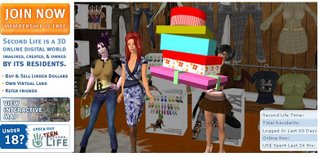Week 5 - The World is Flat : Flatteners 3 & 4 (for Group 2) @H-H@!
I'm prompted to wonder if Kathy's choice of divvying up Chapte 2 between groups is to see if we would all merge upon the same interpretation of Friedman's 'flat world'. He seems to be rather fanatic in sporting his personal terminology all over the text...and in cascadingly context-savy circumstances wherein you might think you hadn't a clue what the hell he meant unless you'd read chapter 1 word for word. Still, he's very good with the prose. And his definitions aren't too hard to deduce. From his anecdote about Wild Brain's production M.O, the flat world looks to be the connected world - able to support simultaneous collaboration and offer access and input to multiple participants. All on the same plane, I suppose, which is perhaps why Friedman chose the visual analogy that he did. In his covering of the 'flows of revolution', that he highlights the 'grassroots' dynamics of connectivity as the primary molder of web innovation. Subscriber demand cast Netscape into new roles that it certainly hadn't originated for. The hallmarks he notes are of the ones involving major steps away from physical necessity. The integration of the PC and email, editable digital content, and standardized digital protocols - all burgeoners of multilateral innovation. Ultimately, Friedman's FLATNESS is digital SEAMLESSNESS.
"Once a standard takes hold, people start to focus on the quality of WHAT they are doing as opposed to HOW they are doing it," Friedman prescribes. TOO TRUE! I'd never really taken the same realization before. Digital innovation seems to come around in such cycles : development, competition, standardization, innovation, saturation, development, compe-... etc, etc. Of course, the ultimate is to have a proprietary standard, owing much to the examples of eBay's acquisition of PayPal and Mac's iTunes among others.
The flattened world is the geek's heyday. Shareware, digital art, blogs, wikipedia...with no commercial intermediaries, the digital ether now offers art for art's sake and logic for logic's sake via the UPLOAD, which seems to be sufficing as the ultimate market equalizer now that the market is digital. Cultivated by communities, uploading spurs a tremendously positive force for creative multiplicity and allows a higher degree of conceptual diversity than ever would have been offered in a top-down-only medium. But he goes on to follow open source software, Wikipedia, and blogging/podcasting, and each of the three have their share of things to apologize for.
It seems self defeating to employ open source as a standard. I don't know enough about programming languages to anticipate the difficulties, but if independent parties are augumenting original open source code and releasing it into the market for free in return, doesn't the standard deviate from itself? The regulation of open source software seems to be the patch system (almost viral sounding from Friedman's Behlendorf | Apache story).
I think the bottom-up approach to innovation works best with his account of Wikipedia. Viral information sharing. And the standard being balanced as a reflection of content edits. I hadn't really realized that anyone can edit any Wikipedia entry. And I'm surprised that more entries aren't radically changed on a continuing basis, what with all the connected anarchists out there. What else interested me was his description of uploading as a means of intercultural communication. A sort of digital play pen where we are all happy to share each other's toys and it would be considered rude to charge our friends to use them. Is the Internet's inherently community-based design at eternal conflict with the top-down mode of control? Top-down excludes participation. It relies on passivity. And Friedman seems to think that day is nearing an end. The new user is interactive and expects the digital liberties to do so.

